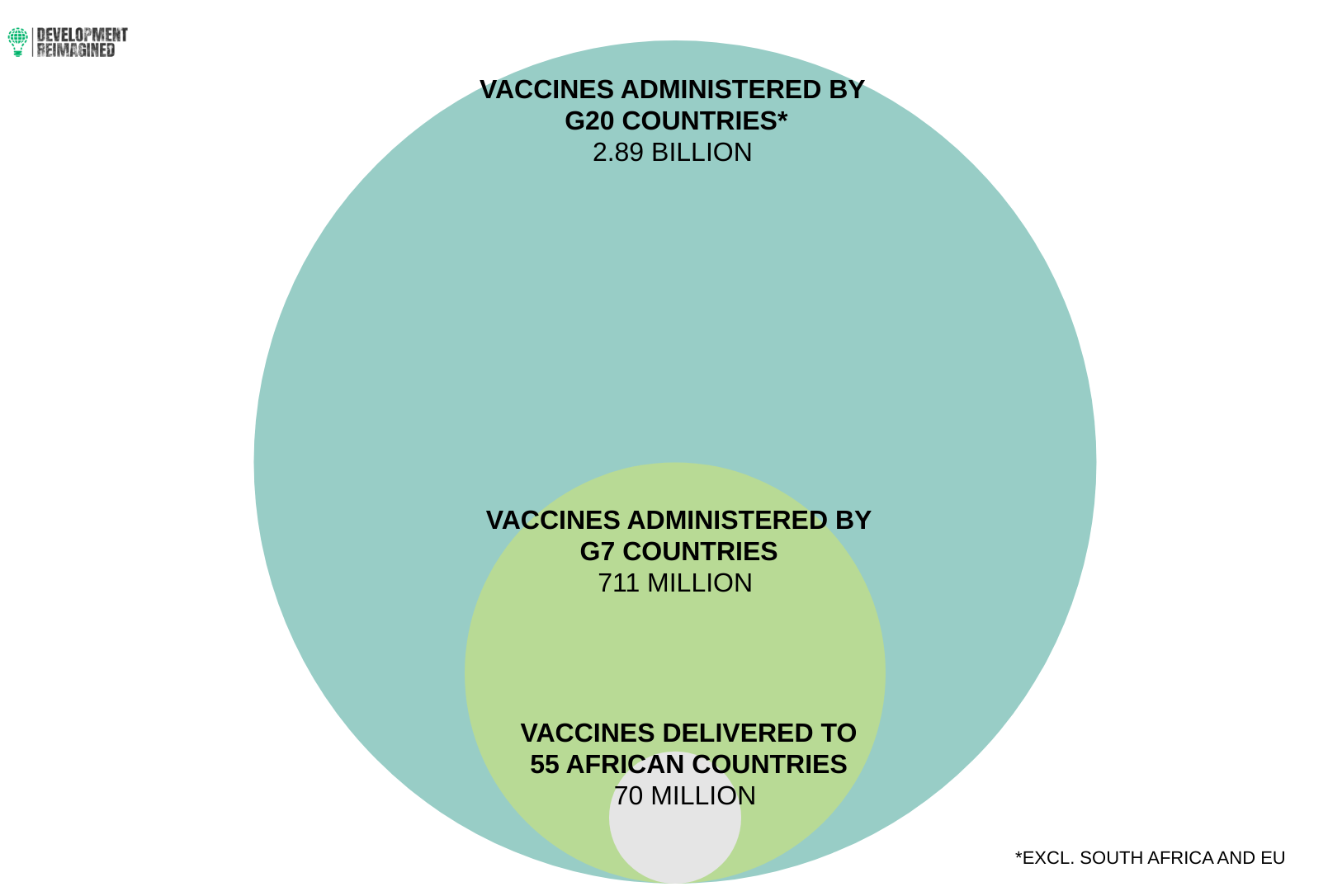Updated Every Month
Over the last three months, we have consistently shared the data that so far, Africa has received less than 2% of global vaccines. We’ve had people share our data and graphics, and call out how inequitable this is, yet the figure has hardly changed. Why?
Perhaps the fact that African countries still account for just over 3% of global cases suggests they can manage. This is true in some ways, but in some ways it’s completely wrong.
While a few African nations are facing new waves of infections, and Africa now ranks 3rd worst for news cases globally – over 90% of which are occurring in just 10 countries, the bigger issue is that the economic cost of locking down and managing borders is high.
For instance, it means African countries that relied on tourism cannot open up, meaning workers remain unemployed, tourism revenues dry up, which means government budgets shrink, and government support for education, health and even infrastructure building become constrained. Right now, due to low vaccine access, to manage COVID19, 24 African countries have determined that they must require quarantine on arrival, holding back tourism and business.
Similarly, low access to vaccines also means other sectors cannot open up – from construction to restaurants and retail. Again, this constrains peoples incomes, constrains government’s tax raising abilities and therefore potential for governments to support their citizens through this difficult time. Currently, 11 African countries are still having to impose curfews on businesses, and 22 have various other social distancing measures in place.
Last but not least, and perhaps worst of all, given African countries’ demographics, continued COVID19 social distancing is limiting the potential for schools to re-open. For instance there are no public gatherings allowed in 14 African countries. This does not just create burdens for parents in African countries but it could also damage the future human capital potential of African children for years to come, especially those with limited access to electricity and the internet, which many African countries lack.
If continued social distancing and management was required worldwide, such as during most of 2020, then this would be understandable. But this is no longer.
On the whole, just 1.2% of the African population has been vaccinated and only 12 African nations have bought or had donated over 1 million vaccines to administer. In comparison, the G20 has collectively vaccinated 22% of their populations on average, and several members boast surplus doses. The Global Alliance for Vaccines and Immunization (GAVI) has now announced two agreements with Sinopharm and Sinovac to produce 550 million doses by the summer of 2022, a fifth of which will be delivered through COVAX. This seems impressive but the reality is it is slow and insufficient – WHO’s approval of Sinopharm was announced two months ago. As our graphic below explains, 32 African nations have now administered over 50% of available vaccines, yet only around 5 million new doses arrived on the continent last month, even though over a billion doses were ordered months ago. In fact, allocating a tiny proportion of the G7’s or G20’s new SDR allocation could purchase Africa’s entire outstanding vaccine order.
With the limited supply of doses coupled with the virulence of new variants, while African countries have so far had time to prepare, local health systems could be overwhelmed, leading to spikes in deaths. Already, 2 African nations have recorded daily death rates exceeding 100.
What can be done?
Faced with such a stark reality, some African governments and organisations are taking matters into their own hands. The Egyptian Government recently announced that it has produced 1 million Sinovac doses through the Egyptian Holding Company for Biological Products and Vaccines (VACSERA). This is the result of agreements signed with Sinovac and Sputnik V back in April. VACSERA aims to produce over 100 million doses annually and Egypt is planning to vaccinate 40% of its population by the end of 2021. Thereafter, Egypt plans to become a vaccine manufacturing hub for the whole continent. So far, it looks like 5 other production hubs on the continent may become a reality in 2021 or 2022.
A year and a half into COVID19, it seems the multilateral system and even many bilateral “aid relationships” are failing African countries. The chances of Africa’s 55 countries of ever knowing “post-COVID19 normality” seems like it will simply have to be determined by their continued, consistent, hard work.
 To review the data yourself, check out the graphics and numbers below, and do let us know what you find surprising, worrying, or reassuring, and what you’d like us to find out next month.
To review the data yourself, check out the graphics and numbers below, and do let us know what you find surprising, worrying, or reassuring, and what you’d like us to find out next month.
To find out how Development Reimagined can support you, your organisation or Government during the COVID-19 outbreak please email the team at clients@developmentreimagined.com .
Special thanks go to Rosie Wigmore, Saeger Godson and Jing Cai for their work on the graphic and collecting/analysing the underlying data and this accompanying article.
The data was collated primarily from Africa CDC, as well as other sources including: government websites and media reports, the IMF policy tracker; Worldometer and the New York Times Vaccine Tracker. Our methodology is entirely in-house, based on analysis of vaccine, testing, spending, social distancing, income categories and other trends.
If you spot any gaps or have any enquiries, please send your feedback to us at team@developmentreimagined.com, we will aim to respond asap.
July 2021


